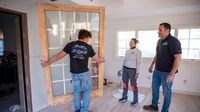As the busy spring season for home remodeling gets underway, one Long Island contractor is already seeing signs of both promise and concern in the market. Joe Persico, president of Hy-Grade Contractors Corp. in Bohemia, said his company is fully booked through 2025 for large-scale renovation projects. He observed consistent demand for high-end remodeling jobs, particularly those priced over $100,000. Contrarily, there's been a noticeable slowdown in requests for smaller scale projects, such as single bathroom updates.
“For incoming work, the smaller scale has definitely slowed off,” Persico noted. “The projects we’re seeing now are full home renovations, high-end bathroom remodels and high-end kitchen remodels.” This trend has been echoed by other experts from the Long Island housing industry, who have mixed feelings about the future of remodeling. While many are optimistic, citing the region's aging housing stock and a limited supply of homes for sale, recent national reports raise red flags regarding overall spending in the remodeling sector.
A new report from the Harvard Joint Center for Housing Studies projects remodeling spending will increase by just 1.1% this year, totaling approximately $608 billion. This figure falls significantly short of the historical average growth rate of about 5% and follows several years of increased spending during the pandemic. Sophia Wedeen, a senior research analyst at the center, highlighted that “Any place that has high incomes and high home values the way Long Island does has strong fundamentals for sustained remodeling activity.” Indeed, 59% of homeowners reported spending at least $50,000 on remodeling, compared to only 44% nationwide.
However, there are various factors that are influencing homeowners to reconsider their remodeling projects. One major concern is the impact of tariffs on construction materials. President Donald Trump’s tariff policies have increased the costs of essential materials like lumber, steel, and aluminum. “That’s going to flow downhill,” remarked Mike Florio, CEO of the Long Island Builders Institute. He explained that the elevated material costs ultimately trickle down to the end-user, resulting in higher project costs for homeowners who have spent around $25.1 billion in remodeling within the metropolitan area in 2023, according to the Harvard report.
Additionally, elevated interest rates have made financing home improvement projects more expensive. As of March 19, 2025, the national average rate for a home equity line of credit stood at 8.03%, which is about double the average rate from three years prior. Stephen Kates, a financial analyst at Bankrate, indicated that homeowners should brace for this financial strain as he does not anticipate a significant drop in rates this year. “We’re not likely to see a quick decrease to rates unless we have a recession, which we do not expect,” Kates added.
Vittorio Scafidi, vice president of lending at Jovia Financial Credit Union, pointed out that homeowners are increasingly turning to home equity lines of credit due to high mortgage rates. “With mortgage rates being so high, this is everyone’s go-to right now,” Scafidi said. The correlation between financial conditions and the remodeling market cannot be overstated; fewer homeowners are selling their homes, and this reluctance translates to a drop in market activity.
The most recent data from OneKey MLS revealed that home sales in the ten New York City area counties, which include Nassau and Suffolk, decreased by 2.5% in 2024 compared to the previous year and were down by about one-third from 2021. Wedeen notes that homeowners preparing their properties for sale and new buyers who renovate before moving into a home typically contribute significantly more to the remodeling industry. Therefore, when market activity dips, it adversely affects remodeling contractors.
“Unfortunately, on Long Island, there’s a very limited inventory of homes,” stated Scafidi, highlighting that the scarcity of suitable homes might lead some residents to consider renovation or building instead of moving. The region is grappling with an aging housing stock, resulting in more widespread investment in repairs and updates. The median Nassau County home was constructed in 1955, while the median Suffolk County home was built in 1970, according to 2023 data from the U.S. Census Bureau.
This aging aspect means that older homes are frequently in need of updates. Persico emphasized that homes built as recently as 2000 are also coming due for renovations. “If you had a home built in 2000, chances are it can use a bathroom, a kitchen, definitely a roof,” he said.
In conclusion, the remodeling market faces a blend of opportunities and challenges this spring season. While the demand for high-end renovations remains strong, factors such as rising material costs and elevated interest rates are causing concern among both contractors and homeowners. As the busy season unfolds, industry experts will be closely monitoring these trends to gauge the future of remodeling on Long Island and beyond.






